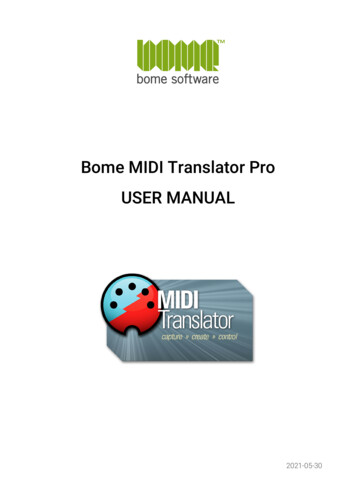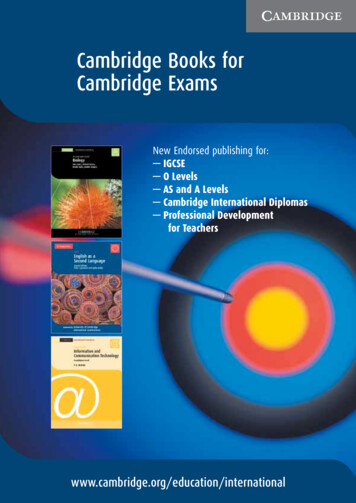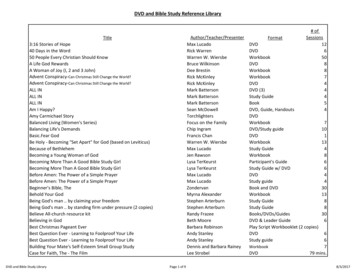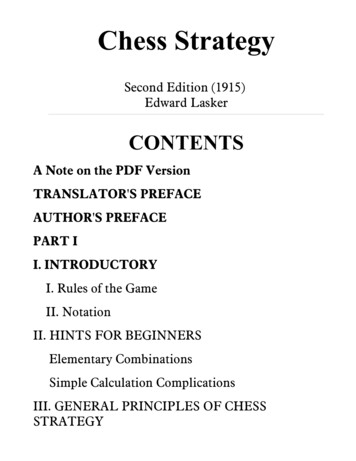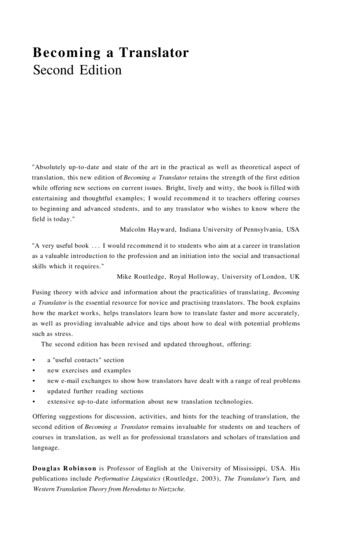
Transcription
Becoming a TranslatorSecond Edition"Absolutely up-to-date and state of the art in the practical as well as theoretical aspect oftranslation, this new edition of Becoming a Translator retains the strength of the first editionwhile offering new sections on current issues. Bright, lively and witty, the book is filled withentertaining and thoughtful examples; I would recommend it to teachers offering coursesto beginning and advanced students, and to any translator who wishes to know where thefield is today."Malcolm Hayward, Indiana University of Pennsylvania, USA"A very useful book . . . I would recommend it to students who aim at a career in translationas a valuable introduction to the profession and an initiation into the social and transactionalskills which it requires."Mike Routledge, Royal Holloway, University of London, UKFusing theory with advice and information about the practicalities of translating, Becominga Translator is the essential resource for novice and practising translators. The book explainshow the market works, helps translators learn how to translate faster and more accurately,as well as providing invaluable advice and tips about how to deal with potential problemssuch as stress.The second edition has been revised and updated throughout, offering: a "useful contacts" section new exercises and examples new e-mail exchanges to show how translators have dealt with a range of real problems updated further reading sections extensive up-to-date information about new translation technologies.Offering suggestions for discussion, activities, and hints for the teaching of translation, thesecond edition of Becoming a Translator remains invaluable for students on and teachers ofcourses in translation, as well as for professional translators and scholars of translation andlanguage.D o u g l a s R o b i n s o n is Professor of English at the University of Mississippi, USA. Hispublications include Performative Linguistics (Routledge, 2003), The Translator's Turn, andWestern Translation Theory from Herodotus to Nietzsche.
Becoming a TranslatorAn Introduction to theTheory and Practice of TranslationSecond EditionDouglas Robinson 3 Routledgej j j Taylor Si Francis GroupLONDON AND NEW YORK
First published 1997 by RoutledgeReprinted 1998, 1999, 2000, 2 0 0 1 , 2002Second edition first published 2003 bv Routledge2 Park Square, Milton Park, Abingdon, Oxon OX 14 4RNSimultaneously published in the USA and Canadaby Routledge270 Madison Avenue, New York, NY 10016Reprinted 2006, 2007Routledge is an imprint of the Taylor Francis Group, an injorma business 1997, 2003 Doug RobinsonTypeset in Perpetua and Futura byKeystroke, Jacaranda Lodge, WolverhamptonPrinted and bound in Great Britain byMPG Books Ltd, Bodmin, CornwallAll rights reserved. No part of this book may be reprinted or reproducedor utilized in any form or by any electronic, mechanical, or other means,now known or hereafter invented, including photocopying and recording,or in any information storage or retrieval system, without permission inwriting from the publishers.British Library Cataloguing in Publication DataA catalogue record for this book is available from the British LibraryLibrary of Congress Cataloging in Publication DataA catalog record for this book has been requestedISBN 978-0 1-15-30032-2 (hbk)ISBN 9 7 8 - 0 - 1 5 - 3 0 0 3 3 - 9 (pbk)
ContentsList offiguresAcknowledgementsIntroduction11 External k n o w l e d g e : the user's v i e wInternal and external knowledgeReliability567Textual reliability7The translator's reliabilityTimelinessxixiii1113Cost 17Trade-offs 17Discussion19Exercises 20Suggestions for further reading 202 Internal k n o w l e d g e : the translator's v i e wWho are translators? 22Professional prideReliability2424Involvement in the profession25Ethics 25Income 28Speed 28Translation memory software 31Project management3221
viContentsRaising the status of the professionEnjoyment3333Discussion 40Exercises 44Suggestions for further reading 453 The translator as learnerThe translator's intelligence4749The translator's memory 50Representational and procedural memoryIntellectual and emotional memory5152Context, relevance, multiple encoding 53The translator's learning styles tructured environment60Independence /dependence 16263Visual 63Auditory64Kinesthetic66Processing ceptual (abstract)6970Concrete (objects and feelings) 70Response 71Externally /internally mental/analytical-reflective74Discussion 75Exercises 76Suggestions for further reading 814 TheprocessoftranslationThe shuttle: experience and habit 84Charles Sanders Peirce on instinct, experience, and habit 8683
Abduction, induction, deduction87Karl Weick on enactment, selection, and retention 88The process of translationDiscussion9095Exercises 95SuggestionsJorfurther reading955 ExperienceWhat experience? 98Intuitive leaps (abduction)100Pattern-building (induction)105Rules and theories (deduction)Discussion106109Exercises 109Suggestions Jor further reading 1106 PeopleThe meaning of a word 112Experiencing people113First impressions (abduction)115Deeper acquaintance (induction)Psychology (deduction)Discussion116122124Exercises 124Suggestions for further reading 1267 Working peopleA new look at terminologyFaking it (abduction)Working (induction)128128131Terminology studies (deduction)DiscussionActivities135138138Exercises 138Suggestions for further reading 140
viiiContents8 Languages141Translation and linguistics142What could that be? (abduction)143Doing things with words (induction)146The translator and speech-act theory (deduction)Discussion148152Exercises 152Suggestions for further reading 1589 Social networks159The translator as social beingPretending (abduction)160161Pretending to be a translator 161Pretending to be a source-language reader and target-language writerPretending to belong to a language-use communityLearning to be a translator (induction)164165168Teaching and theorizing translation as a social activity (deduction)170Discussion 1 76Exercises 177Suggestions for further reading 18310 Cultures185Cultural knowledge186Self-projection into the foreign (abduction) 189Immersion in cultures (induction)192Intercultural awareness (deduction)Discussion194200Exercises 200Suggestions for further reading 20511 When habit failsThe importance of analysis207208The reticular activation system: alarm bells 210Checking the rules (deduction)213Checking synonyms, alternatives (induction)219Picking the rendition that feels right (abduction) 220
Contents ixDiscussion 221Exercise 221Suggestions JorJurther reading 222Appendix: Translation-related resourcesAppendixJor223teachers241Works cited287Index297
Figures12345678Learning stylesPeirce's instinct/experience/habit triad in translationPeirce's instinct/experience/habit and abduction/induction/deduction triads in translationThe wheel of experienceThe translator's experience of terminologyThe "basic situation for translatorial activity"The systematic assessment of flow in daily experienceChannels of learning58—9878992137180212249
AcknowledgementsThis book has taken shape in interaction with teachers and students of translationin the United States, Mexico, Puerto Rico, Brazil, and England. Eileen Sullivan'sinvitation to tour central Mexico in the fall of 1994 first got me started on the seriesof interactive hands-on experiences that eventually turned into these chapters; andwhile many of the participants in my seminars in Guadalajara, Mexico D.F., Tlaxcala,Xalapa, and Veracruz were enthusiastic, I owe even more to the skeptics, who forcedme to recognize such things as the importance of the "slow" or analytical side of theshuttle movement explored here. Thanks especially to Richard Finks Whitaker,Teresa Moreno, Lourdes Arencibo, Adriana Menasse, and Pat Reidy in Mexico;Marshall Morris, Angel Arzan, Yvette Torres, and Sara Irizarry in Puerto Rico; JohnMilton, Rosemary Arrojo, John Schmidt, Regina Alfarano, Maria Paula Frota, andPeter Lenny in Brazil; Peter Bush, Mona Baker, and Terry Hale in England.Several people read early drafts of the book in part or in whole, and made helpfulcomments: Anthony Pym, Beverly Adab, and Maria O'Neill. Bill Kaul's pictorialand other comments were as usual least helpful and most enjoyable.I owe a special debt of gratitude to my friends and fellow translators onLantra-L, the translators' on-line discussion group, who have graciously consentedto being quoted repeatedly in these pages. A lonely translator could not ask for morededicated help, support, advice, and argument!Special thanks go to all the teachers and other learners who have used this bookin various contexts around the world, and then shared their experiences with me.In updating and revising the book I have not been able to make all the changes theysuggested, but every suggestion initiated a thought process that contributed in somesignificant way to the final form the revision took. Christy Kirkpatrick at Routledgesolicited extensive responses from teachers who have used the book; thanks to her,and to them, for that valuable assistance. Some of my old friends on Lantra-L pitchedin once again, offering often lengthy disquisitions on what should be added,subtracted, or updated, especially in the area of translation memory. Thanks inparticular (in alphabetical order) to Enrica Ardemagni, Michelle Asselin, MichaelBenis, Manon Bergeron, Tony Crawford, Helen Elliott, Maureen Garelick, SharonGrevet, and Kirk McElhearn.
IntroductionThe present-day rapid development of science and technology, as well as thecontinuous growth of cultural, economic, and political relations betweennations, have confronted humanity with exceptional difficulties in the assimilation of useful and necessary information. No way has yet been found to solvethe problems in overcoming language barriers and of accelerated assimilationof scientific and technological achievements by either the traditional or modernmethods of teaching. A new approach to the process of teaching and learningis, therefore, required if the world is to meet the needs of today and tomorrow.Georgi Lozanov, Suggestologj and Outlines of Suggestopedy (1971)The study of translation and the training of professional translators is without questionan integral part of the explosion of both intercultural relations and the transmission of scientific and technological knowledge; the need for a new approach to theprocess of teaching and learning is certainly felt in translator and interpreter trainingprograms around the world as well. How best to bring student translators up to speed,in the literal sense of helping them to learn and to translate rapidly and effectively?How best to get them both to retain the linguistic and cultural knowledge and tomaster the learning and translation skills they will need to be effective professionals?At present the prevailing pedagogical assumptions in translator training programsare (1) that there is no substitute for practical experience — to learn how to translateone must translate, translate, translate — and (2) that there is no way to acceleratethat process without damaging students' ability to detect errors in their own work.Faster is generally better in the professional world, where faster translators —provided that they continue to translate accurately — earn more money; but it isgenerally not considered better in the pedagogical world, where faster learners arethought to be necessarily careless, sloppy, or superficial.This book is grounded in a simultaneous acceptance of assumption (1) and rejection of assumption (2). There is no substitute for practical experience, and translatortraining programs should continue to provide their students with as much of it asthey can. But there are ways of accelerating that process that do not simply fosterbad work habits.
2 IntroductionThe methodological shift involved is from a pedagogy that places primaryemphasis on conscious analysis to a pedagogy that balances conscious analysis withsubliminal discovery and assimilation. The more consciously, analytically, rationally,logically, systematically a subject is presented to students, and the more consciouslyand analytically they are expected to process the materials presented, the moreslowly those materials are internalized.And this is often a good thing. Professional translators need to be able to slowdown to examine a problematic word or phrase or syntactic structure or culturalassumption painstakingly, with full analytical awareness of the problem and itspossible solutions. Slow analysis is also a powerful source of new knowledge.Without the kinds of problems that slow the translation process down to a snail'space, the translator would quickly fall into a rut.The premise of this book is, however, that in the professional world slow,painstaking, analytical learning is the exception rather than the rule — and shouldbe in the academic world of translator training as well. All humans learn better,faster, more effectively, more naturally, and more enjoy ably through rapid andholistic subliminal channels. Conscious, analytical learning is a useful check on moreefficient learning channels; it is not, or at least it should not be, the only or evenmain channel through which material is presented.This book, therefore, is set up to shuttle between the two extremes of subliminalor unconscious learning, the "natural" way people learn outside of class, andconscious, analytical learning, the "artificial" way people are traditionally taught inclass. As teaching methods move away from traditional analytical modes, learningspeeds up and becomes more enjoyable and more effective; as it approaches thesubliminal extreme, students learn enormous quantities of material at up to tentimes the speed of traditional methods while hardly even noticing that they'relearning anything. Because learning is unconscious, it seems they haven't learnedanything; to their surprise, however, they can perform complicated tasks much morerapidly and confidently and accurately than they ever believed possible.Effective as these subliminal methods are, however, they are also somewhatmindless, in the sense of involving very little critical reflection, metathinking, testingof material against experience or reason. Translators need to be able to processlinguistic materials quickly and efficiently; but they also need to be able to recognizeproblem areas and to slow down to solve them in complex analytical ways. The mainreason for integrating conscious with subliminal teaching methods is that learnersneed to be able to test and challenge the materials and patterns that they sublimateso quickly and effectively. Translators need to be able to shuttle back and forthbetween rapid subliminal translating and slow, painstaking critical analysis — whichmeans not only that they should be trained to do both, but that their training shouldembody the shuttle movement between the two, -subliminal. Translators need to be able not only to performboth subliminal speed-translating and conscious analytical problem-solving, but also
Introduction 3to shift from one to the other when the situation requires it (and also to recognizewhen the situation does require it).Hence the rather strange look of some of the chapters, and especially the exercisesat the end of the chapters. Teachers and students accustomed to traditional analyticalpedagogies will probably shy away at first from critical perspectives and hands-onexercises designed to develop subliminal skills. And this critical caution is a goodthing: it is part of the shuttle movement from subliminal to conscious processing.The topics for discussion that precede the exercises at the end of every chapter arein fact designed to foster just this sort of critical skepticism about the claims madein the chapter. Students should be given a chance both to experience the power ofsubliminal learning and translating and to question the nature and impact of whatthey are experiencing. Subliminal functioning without critical self-awareness quicklybecomes mind-numbing mechanical routine; analytical critiques without rich playfulexperience quickly become inert scholasticism.The primary course for which this textbook is intended is the introduction to thetheory and practice of translation. Such introductory courses are designed to giveundergraduate (and, in some cases, graduate) students an overall view of whattranslators do and how translation is studied. To these ends the book is full ofpractical details regarding the professional activities of translators, and in Chapters6—10 it offers ways of integrating a whole series of theoretical perspectives ontranslation, from psychological theories in Chapter 6 through terminologicaltheories in Chapter 7, linguistic theories in Chapter 8, and social theories in Chapter9 to cultural theories in Chapter 10.In addition, however, the exercises are designed not only to teach about translationbut to help students translate better as well; and the book might also be used assupplementary material in practical translation seminars. Since the book is notwritten for a specific language combination, the teacher will have to do some workto adapt the exercises to the specific language combination in which the studentsare working; while suggestions are given on how this might be done, it would beimpossible to anticipate the specific needs of individual students in countries aroundthe world. If this requires more active and creative input from teachers, it also allowsteachers more latitude to adapt the book's exercises to their students' needs.Since most translators traditionally (myself included) were not trained for thejob, and many still undergo no formal training even today, I have also set up the bookfor self-study. Readers not currently enrolled in, or employed to teach in, translatortraining programs can benefit from the book by reading the chapters and doing theexercises that do not require group work. Many of the exercises designed for groupwork can easily be adapted for individuals. The main thing is doing the exercises andnot just thinking about them. Thought experiments work only when they are trulyexperiments and not just reflection upon what this or that experiment might be like.
1External knowledge:the user's view Internal and external k n o w l e d g e6 Reliability7 Textual reliability7 The translator's reliability11 Timeliness13 Cost17 Trade-offs17 Discussion19 Exercises20 Suggestions for further reading20
THESIS: Translation can be perceived from the outside, from the client's orother user's point of view, or from the inside, from the translator's point ofview; and while this book takes the translator's perspective, it is useful to begin witha sense of what our clients and users need and why.Internal and external knowledgeTranslation is different things for different groups of people. For people who arenot translators, it is primarily a text; for people who are, it is primarily an activity.Or, as Anthony Pym (1993: 131, 149-50) puts it, translation is a text from theperspective of "external knowledge," but an activity (aiming at the production of atext) from the perspective of "internal knowledge."InfernalExternalA translator thinks and talks aboutA non-translator (especially a mono-translation from inside the process,lingual reader in the target languageknowing how it's done, possessingwho directly or indirectly pays for thea practical real-world sense of thetranslation - a client, a book-buyer)problems involved, some solutions tothinks and talks about translation fromthose problems, and the limitations onoutside the process, not knowing howthose solutions (the translator knows,it's done but knowing, as Samuelfor example, that no translation willJohnsonever be a perfectly reliable guide tocarpenter, a well-made cabinet whenthe original).s/he sees one.oncesaid of thenon-From the translator's internal perspective, the activity is most important: the processof becoming a translator, receiving and handling requests to do specific translations,doing research, networking, translating words, phrases, and registers, editing thetranslation, delivering the finished text to the employer or client, billing the clientfor work completed, getting paid. The text is an important part of that process, ofcourse — even, perhaps, the most important part — but it is never the whole thing.From the non-translator's external perspective, the text as product or commodityis most important. And while this book is primarily concerned with (and certainly
The user's view 7written from and for) the translator's internal knowledge, and thus with the activityof translating — it is, after all, a textbook for student translators — it will be usefulto project an external perspective briefly here in Chapter 1, if only to distinguish itclearly from the more translator-oriented approach of the rest of the book. A greatdeal of thinking and teaching about translation in the past has been controlled bywhat is essentially external knowledge, text-oriented approaches that one mighthave thought of greater interest to non-translators than translators — so much, infact, that these external perspectives have in many ways come to dominate the field.Ironically enough, traditional approaches to translation based on the nontranslating user's need for a certain kind of text have only tended to focus on oneof the user's needs: reliability (often called "equivalence" or "fidelity"). A fully useroriented approach to translation would recognize that timeliness and cost are equallyimportant factors. Let us consider these three aspects of translation as perceivedfrom the outside — translation users' desire to have a text translated reliably, rapidly,and cheaply — in turn.ReliabilityTranslation users need to be able to rely on translation. They need to be able touse the translation as a reliable basis for action, in the sense that if they take actionon the belief that the translation gives them the kind of information they need aboutthe original, that action will not fail because of the translation. And they need to beable to trust the translator to act in reliable ways, delivering reliable translations bydeadlines, getting whatever help is needed to meet those deadlines, and beingflexible and versatile in serving the user's needs. Let's look at these two aspects oftranslation reliability separately.TextualreliabilityA text's reliability consists in the trust a user can place in it, or encourage others toplace in it, as a representation or reproduction of the original. To put that differently,a text's reliability consists in the user's willingness to base future actions on anassumed relation between the original and the translation.For example, if the translation is of a tender, the user is most likely the companyto which the tender has been made. "Reliability" in this case would mean that thetranslation accurately represents the exact nature of the tender; what the companyneeds from the translation is a reliable basis for action, i.e., a rendition thatmeticulously details every aspect of the tender that is relevant to deciding whetherto accept it. If the translation is done in-house, or if the client gives an agency orfreelancer specific instructions, the translator may be in a position to summarizecertain paragraphs of lesser importance, while doing painstakingly close readingsof certain other paragraphs of key importance.
8The user's viewOr again, if the translation is of a literary classic, the user may be a teacher orstudent in a class that is reading and discussing the text. If the class is taught in amother-tongue or comparative literature department, "reliability" may mean thatthe users agree to act as if the translation really were the original text. For thispurpose a translation that reads as if it had originally been written in the targetlanguage will probably suffice. If the class is an upper-division or graduate coursetaught in a modern-language or classics department, "reliability" may mean that thetranslation follows the exact syntactic contours of the original, and thus helpsstudents to read a difficult text in a foreign language. For this purpose, various "cribs"or "interlinears" are best — like those New Testament translations published for thebenefit of seminary students of Greek who want to follow the original Greek textword for word, with the translation of each word printed directly under the wordit renders.Or if the translation is of advertising copy, the user may be the marketingdepartment in the mother company or a local dealer, both of whom will presumablyexpect the translation "reliably" to sell products or services without makingimpossible or implausible or illegal claims; or it may be prospective customers, whomay expect the translation to represent the product or service advertised reliably,in the sense that, if they should purchase one, they would not feel that the translationhad misrepresented the actual service or product obtained.As we saw above, this discussion of a text's reliability is venturing into theterritory traditionally called "accuracy" or "equivalence" or "fidelity." These termsare in fact shorthand for a wide variety of reliabilities that govern the user's externalperspectives on translation. There are many different types of textual reliability;there is no single touchstone for a reliable translation, certainly no single simpleformula for abstract semantic (let alone syntactic) "equivalence" that can be appliedeasily and unproblematically in every case. All that matters to the non-translatinguser is that the translation be reliable in more or less the way s/he expects(sometimes unconsciously): accurate or effective or some combination of the two;painfully literal or easily readable in the target language or somewhere in the middle;reliable for her or his specific purposes.A text that meets those demands will be called a "good" or "successful"translation, period, even if another user, with different expectations, might considerit bad or unsuccessful; a text considered a failure by some users, because it doesn'tmeet their reliability needs, might well be hailed as brilliant, innovative, sensitive,or highly accurate by others.It is perhaps unfortunate, but probably inevitable, that the norms and standardsappropriate for one group of users or use situations should be generalized to applyto all. Because some users demand literal translations, for example, the idea spreadsthat a translation that is not literal is no translation at all; and because some usersdemand semantic (sense-for-sense) equivalence, the idea spreads that a translationthat charts its own semantic path is no translation at all.
The user's view 9Thus a free retelling of a children's classic may be classified as an "adaptation"rather than a translation; and an advertising translation that deviates strikingly fromthe original in order to have the desired impact on target readers or viewers (i.e.,selling products or services) may be thought of as a "new text" rather than as anadvertising translation.Each translation user, limited to the perspective of her or his own situationalneeds, may quite casually fall into the belief that those needs aren't situational at all,indeed aren't her or his needs at all, but simply the nature of translation itself. Alltranslation is thus-and-such — because this translation needs to be, and how differentcan different translations be? The fact that they can be very different indeed is oftenlost on users who believe their own expectations to be the same as everyone else's.This mistaken belief is almost certainly the source of the quite widespread notionthat "fidelity," in the sense of an exact one-to-one correspondence between originaland translation, is the only goal of translation. The notion arises when translationis thought of exclusively as a product or commodity (rather than as an activity orprocess), and when the reliability of that product is thought of narrowly in termsof exact correspondence between texts (rather than as a whole spectrum of possibleexchanges).Reliably translated texts cover a wide range from the lightly edited to thesubstantially rewritten, with the "accurate" or "faithful" translation somewhere inthe middle; there is no room in the world of professional translation for thetheoretical stance that only straight sense-for-sense translation is translation,therefore as a translator I should never be expected to edit, summarize, annotate,or re-create a text.While some effort at user education is probably worthwhile, it is usually easierfor translators simply to shift gears, find out (or figure out) what the user wants orneeds or expects, and provide that — without attempting to enlighten the user aboutthe variability and volatility of such expectations. Many times clients' demands areunreasonable, unrealistic, even impossible — as when the marketing manager of acompany going international demands that an advertising campaign in fourteendifferent languages be identical to the original, and that the translators in all fourteenlanguages show that this demand has been met by providing literal backtranslationsof their work. Then the translators have to decide whether they are willing toundertake the job at all; and if so, whether they can figure out a way to do it thatsatisfies the client without quite meeting her or his unreasonable demands.For the hard fact is that translators, with all their internal knowledge, can rarelyafford to ignore the external perspectives of non-translators, who are, after all, thesource of our income. As Anthony Pym (1993: 149) notes wryly, in conver
Becoming a Translator Second Edition "Absolutely up-to-date and state of the art in the practical as well as theoretical aspect of translation, this new edition of Becoming a Translator retains the strength of the first edition while offering new sections on current
